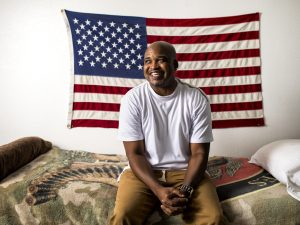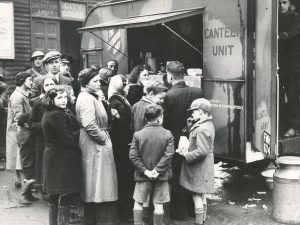by Sue Schumann Warner –
Delegates to The Salvation Army’s National Disaster Training Conference, held in Tampa, Fla., nearly had a first-hand experience with disaster the day the conference began, as Hurricane Floyd hurtled toward Florida’s coast at 155 miles per hour.
Although Floyd’s force eventually veered north, almost a quarter of the nearly 600 registered delegates did not attend the conference, remaining on duty in Florida, Georgia, and the Carolinas, ready to provide emergency relief services to hurricane victims. More than 2.5 million coastal residents along the nation’s eastern seaboard were evacuated–and in many locations, the Army was there providing meals to emergency workers and evacuees at rest stops.
“While Hurricane Floyd cost us in delegates,” stated Major Tom Vick, Florida divisional director of disaster services, “it has given people (here) a first hand look at what happens in this part of the country.”
Titled “Melding Mission with Ministry,” the conference not only acknowledged the clear need for the Army to better prepare its personnel for growing demands and expectations in disaster preparedness, response, recovery, and restoration efforts, but also voiced the concern for disaster services to play a greater role within Army programming. In addition, the need for The Salvation Army to clarify and strengthen its role as a major presence in disaster relief on a national level, particularly in aviation disasters, was expressed.
Importance of the conference
In his opening remarks, National Commander Commissioner John Busby stated that the training and certification afforded by the conference made this an historic gathering. “The importance of the conference training program can’t be over-emphasized.” He noted that the Army is faced with unrelenting challenges and unprecedented opportunities, and explained that when Hurricane Andrew hit Florida in 1992, it heralded a new day in disaster services: the start of the Army’s collaboration with government agencies, private foundations, and business. He cautioned that “we can only slide so far on the grease of the Salvation Army doughnut. Disaster services is a part of our history, and will develop as a significant part…whenever, whatever, wherever disaster strikes, the red Salvation Army shield will be there.”
Shift in disaster services
The conference reflected a shift in the Army’s role in disaster services. “The Salvation Army has a new focus, a new paradigm of service and ministry,” said National Disaster Services Coordinator Maj. David Dalberg, who later likened the shift “to going from warp speed to a whole new galaxy.” He noted the event marked a level of training new to the Army.
“We can’t just say we’ll show up and do our own thing,” said Tom Mc Sherry, the West’s disaster consultant. “Disaster services is an important mission of the Army. It’s not to be taken lightly.”
McSherry taught a pre-conference certificate course on Critical Incident Stress Management. “It’s crucial that we support our disaster personnel,” he said. “We need to equip them mentally, emotionally, spiritually to do the work. This course trains people to care for the caregivers in a disaster setting: officers, employees and volunteers, and will allow The Salvation Army to become more professional in providing disaster services.”
On a personal note to delegates, Grand Forks Mayor Pat Owens spoke highly of the Army’s assistance in the 1997 floods. “The Salvation Army was on the front line in the flood and fires,” she said. “You are one of the most fantastic organizations I’ve had the opportunity to be involved with.” She related the devastation the flooding caused and stated it will take eight more years for the community to recover. “We’re still rebuilding…on a foundation of faith. We can’t fail.”
Her expression of faith was echoed by John and Eleanor Seaman, Family Memorial Foundation, who have asked The Salvation Army to partner with the foundation in developing and operating direct services to families of aircraft disaster victims. The Seamans lost a niece on TWA’s Flight 800, which exploded near Long Island. “Joining forces with the Army will provide help, and will assist in the healing process,” said Eleanor. Dalberg serves on the foundation’s board.
Federal Aviation Family Assistance Act
Of concern was the report by Richard Verma, an attorney with the Washington, D.C. law firm of Steptoe & Johnson, regarding recent legislation–the Federal Aviation Family Assistance Act of 1996–that, by designating the Red Cross as the emergency care provider at aviation disasters, denies The Salvation Army access to provide their traditional assistance without the Red Cross’ permission. “This was well-meaning legislature with unintended effects,” said Verma. “Let me tell you, Congress has unwavering respect and admiration for The Salvation Army.”
Verma and Dalberg have worked together for the Army in proposing a solution to this problem, and have met three times with the National Transportation Safety Board (NSTB), which, acting as an agency of the government, can change the regulation. At their last meeting in July, they proposed a number of specific ways in which the Army might be designated a care provider. “The Salvation Army needs to define what it does best, and make that clear to the government.” Verma is donating his time and expertise to assist the Army. “I’m confident The Salvation Army is the best in a number of areas. That’s why it’s so easy to represent it in Washington,” he said.
One NAB member with a commitment to disaster services–and long time experience with private and federal agencies in that regard–is Marilyn Quayle, who serves as the chair of the board’s disaster and communication’s committee. Speaking with New Frontier on the unique opportunity of board members to impact the Army’s decision making process, she said, “I see the role of the national advisory board as a spark plug for new ideas,” she said. “We get a lot of input from the field, which we can pass along directly to the Commissioner’s Conference. We can make suggestions others may be reluctant to make.”
In addressing the conference, Quayle said “I think of natural and human disasters as God’s wake-up call to us, and as an opening to your ministry. For many, their first contact with God is through your hands.”











